Guest blog post by Shinichi Nakahara
A new Amazonian butterfly
In a drawer of the butterfly collection at the Natural History Museum in London (NHMUK) sit a handful of rather unassuming butterfly specimens from Amazonia. Marked only with a couple of bands and eyespots on the underside of their wings, these specimens were thought to be pitch-brown black-eyed satyrs (Euptychia picea) for over 150 years. Labels attached to some of them suggest that they were collected by 19th-century naturalist Alfred Russel Wallace during his expedition to the Amazon rainforest along with his good friend, Henry Walter Bates. A recent 300-page monographic study of this group of butterflies has recognised these specimens as a species new to science: Euptychia andrewberryi, or Berry’s black-eyed satyr.


A monograph by a team of international researchers revised the diverse Neotropical butterfly genus Euptychia. The study was led by Shinichi Nakahara, a Lepidoptera subject editor for ZooKeys, Biodiversity Data Journal, and Neotropical Biology and Conservation.
The story behind the eponym
In 1848, Wallace and Bates set sail on an epic voyage for the Amazon to explore and research its neotropical biodiversity. Their trip was funded by Samuel Stevens, a natural history agent in London. In 1852, after four years of collecting, Wallace returned from Brazil with all his specimens loaded on a ship named the Helen. However, on his way back to London, the Helen caught fire in the middle of the Atlantic Ocean and sank. In the blink of an eye, Wallace lost all of his material. This shipwreck is one of the most disastrous events in the history of science, yet fortunately some of Wallace’s Amazonian material escaped the tragedy and made its way to London.
Throughout the course of his travels in Amazonia, Wallace occasionally shipped back specimens to Stevens in London. In a letter to Stevens, dated 15 November 1849, Wallace wrote from Santarém (500 miles above Pará), “I spent about three weeks at Montealegre and have now been back here nearly a month, so before I leave for the Rio Negro, I send you a small lot of insects; they consist almost entirely of Lepidoptera…”
The registration records at the NHMUK suggest that the holotype of Euptychia andrewberryi entered the collection in 1850, supporting the notion that it was shipped to London while Wallace was still in Brazil.
Andrew J. Berry is a historian of science with a long-standing interest in Wallace. A lecturer in the Department of Organismic and Evolutionary Biology at Harvard University, Andrew teaches evolutionary biology and related subjects. While working on the Euptychia monograph, Andrew’s dry sense of humor and undying zest were critical in the completion of a study of such great magnitude.
Why monographs are important
Taxonomic monographs serve as a foundation for understanding species diversity and phylogenetic relationships within a given group of organisms. They enhance our understanding of the myriad species with which we share our planet. Undertaking work on a monograph typically requires travelling to many museums, incorporating morphological and molecular studies, and conducting field work, as well as reviewing literature to solve taxonomic or nomenclatural conundrums. Despite this tedious process, which requires a great deal of perseverance, monographs underscore the rather underappreciated nature of taxonomy, representing “a small gain for a huge effort.” Unfortunately, most diverse tropical groups of organisms have not yet received a comprehensive taxonomic treatment.
Euptychia is the largest Neotropical satyrine genus ever to be revised. This monograph increased the known diversity of Euptychia to 50 species, significantly more than hitherto estimated. Although further testing is needed, it is worth emphasising that only 16 described species were recognised in the genus in 2004. It is remarkable to realise that such a profound discrepancy existed between perceived and actual species richness, especially within a well-studied group of invertebrates such as butterflies. This further underscores the importance of revisionary monographic works.











































































